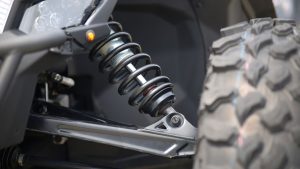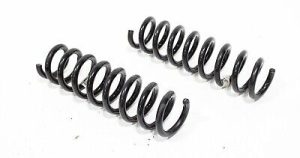Suspension springs are vital components of a vehicle’s chassis, playing a key role in how your car handles road forces, maintains comfort, and most importantly—how it performs during braking and acceleration. While often overshadowed by components like brake pads, tires, or shock absorbers, springs are foundational in ensuring vehicle stability and control.
In this article, we’ll explore how suspension springs influence braking and acceleration dynamics, the types of springs used in vehicles, signs of spring wear, and best practices for maintenance. By understanding their role, you’ll gain deeper insight into vehicle behavior and performance.
The Role of Suspension Springs in Vehicle Dynamics

Suspension springs act as the primary load-bearing components of a suspension system. They support the vehicle’s weight, absorb road shocks, and work in conjunction with shock absorbers to control wheel motion.
During braking and acceleration, springs directly influence:
-
Weight transfer
-
Traction and grip
-
Chassis stability
-
Brake dive and acceleration squat
Let’s break these down:
| Driving Action | Spring Function |
|---|---|
| Braking | Control weight transfer to front wheels (reduce dive) |
| Acceleration | Manage rear suspension compression (limit squat) |
| Cornering | Stabilize roll movement and maintain tire contact |
| Uneven terrain | Absorb road undulations and maintain alignment |
How Springs Affect Braking Dynamics
When you brake, your vehicle’s weight shifts forward. This is known as brake dive. Springs compress under this forward load, and their stiffness/responsiveness dictates how much the nose dips.
Impact of Springs on Braking:
-
Soft Springs
-
Allow excessive nose dive
-
Reduce rear-wheel contact
-
Increase stopping distance
-
Cause instability during emergency braking
-
-
Stiff Springs
-
Limit body dive
-
Maintain even brake force distribution
-
Enhance traction
-
Shorten stopping distance
-
A poorly balanced spring setup can make a vehicle unpredictable during hard braking.
How Springs Affect Acceleration Dynamics
Under acceleration, weight shifts to the rear. The rear springs compress, while the front end may rise (acceleration squat). This dynamic affects traction and torque delivery.
Effect of Spring Characteristics:
-
Under-Sprung Rear Suspension:
-
Excessive squat
-
Loss of front-wheel contact (in FWD)
-
Reduced control and uneven traction
-
-
Properly Tuned Rear Springs:
-
Better torque transfer
-
Enhanced traction in RWD and AWD
-
Minimized body movement for quicker throttle response
-
| Spring Stiffness | Acceleration Result |
|---|---|
| Too Soft | Excessive squat, less front-end control |
| Ideal Balance | Balanced traction and vehicle response |
| Too Stiff | Harsh ride, loss of compliance, wheel hop possible |
Types of Suspension Springs
| Spring Type | Description | Typical Use |
|---|---|---|
| Coil Springs | Helical springs that compress vertically | Most passenger cars and SUVs |
| Leaf Springs | Flat, layered strips of steel | Trucks, heavy-duty vehicles |
| Torsion Bars | Metal rods that twist to provide spring action | Some older vehicles, trucks |
| Air Springs | Use air pressure to support load and adjust height | Luxury cars, buses, tuners |
Each spring type handles load and dynamics differently. Coil springs are most common and are often tuned for specific driving conditions.
Signs Your Springs Are Affecting Braking/Acceleration
If your car feels unstable during rapid deceleration or launches poorly from a stop, your springs may be the issue.
Common Symptoms:
-
Excessive nose dive when braking
-
Rear end squats too much under acceleration
-
Bouncy ride and poor weight transfer
-
Uneven tire wear due to inconsistent suspension travel
-
Clunking noises over bumps (possible spring fatigue or breakage)
Maintenance Tips for Optimal Spring Performance
To maintain braking and acceleration efficiency, keep your suspension springs in top shape:
-
Inspect springs every 20,000–30,000 km
-
Replace damaged or sagging springs
-
Check for corrosion, cracks, or misalignment
-
Always replace springs in pairs (front or rear)
-
Upgrade to performance springs for enhanced driving dynamics
Bonus tip: If replacing shocks, also inspect your springs — these components work together and wear similarly over time.
Performance Upgrades and Spring Tuning
For enthusiasts or those who drive in demanding conditions, upgrading springs can dramatically improve acceleration and braking dynamics.
| Upgrade Type | Benefit |
|---|---|
| Lowering Springs | Lower center of gravity, less dive/squat |
| Progressive Springs | Softer ride at normal load, stiffer at heavy load |
| Performance Coilovers | Fully adjustable height and stiffness |
| Air Suspension | Adjustable ride height and firmness on-the-fly |
Cost of Replacing Suspension Springs
| Component | Average Cost (EUR) |
|---|---|
| Standard coil spring (each) | €40 – €100 |
| Performance coil spring (each) | €100 – €250 |
| Labor (pair installation) | €100 – €200 |
| Alignment after replacement | €50 – €80 |
Where to Buy High-Quality Suspension Springs

To ensure your vehicle’s braking and acceleration performance remains sharp and responsive, always choose high-quality, OEM-grade or performance-rated springs.
Buy Springs & Components online
Final Thoughts
Suspension springs are far more than ride comfort components — they directly influence how your vehicle brakes, accelerates, and handles road forces. A well-maintained and properly tuned spring setup ensures:
-
Improved stopping power
-
Quicker throttle response
-
Better stability during weight shifts
-
Safer and more enjoyable driving experience
Don’t overlook your springs. Inspect them regularly, upgrade if needed, and match them with the right shocks and suspension geometry for the best driving dynamics possible.